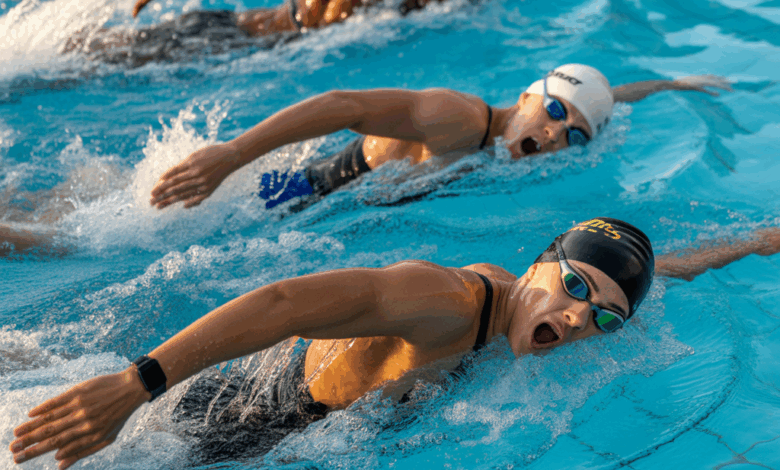Essential Endurance Swim Workouts For Everyone

Ever finish a swim session feeling winded after just a few laps and wonder how some people glide effortlessly for miles? Whether you’re training for a triathlon, trying to keep up with kids at the lake, or simply want a fitter heart and calmer mind, “essential endurance swim workouts for everyone” can turn that frustration into steady progress. This guide breaks down smart, practical swim training that fits beginners through seasoned swimmers.
Why Endurance Swimming Matters
Endurance swim training improves cardiovascular fitness, muscular endurance, and efficient breathing — all while being low-impact on joints. For many people, the pool becomes a sustainable way to maintain fitness year-round. Beyond physical benefits, swim endurance builds confidence for open-water swims and enhances recovery for runners and cyclists through cross-training.
Principles Behind Effective Endurance Swim Workouts
- Consistency over intensity: Frequent moderate sessions beat sporadic intense workouts for building aerobic capacity.
- Progressive overload: Gradually increase distance, time, or intensity to avoid plateaus and injury.
- Technique first: Good form reduces drag and saves energy — focus on stroke efficiency before increasing volume.
- Variety: Mixing intervals, steady-state swims, drills, and open-water practices keeps adaptation and motivation high.
Essential Endurance Swim Workouts for Everyone
Below are structured swim workouts you can use as templates. Pick a level and progress by adding distance, interval intensity, or extra sets each week.
Beginner: Build a Base (30–45 minutes)
- Warm-up: 200m easy swim + 4 x 25m drills (catch-up or fingertip drag), 15s rest
- Main set: 6 x 100m at conversational pace, 20–30s rest between repeats (focus on steady breathing)
- Drill set: 4 x 50m kick (with board) or pull (with buoy), 20s rest
- Cool-down: 100–200m easy
Goal: Accumulate 800–1,200 meters. Emphasize relaxed breathing and consistent pace.
Intermediate: Interval Endurance (45–60 minutes)
- Warm-up: 300m mixed swim + 6 x 50m build (increase speed each 50), 15s rest
- Main set: 4 x (3 x 200m @ moderate pace, 20s rest between 200s), 60s rest between sets
- Speed set: 8 x 50m @ a little faster than goal pace, 20–30s rest
- Cool-down: 200m easy
Goal: 2,000–3,000 meters. Use a tempo pace where you can hold conversation only in short phrases.
Advanced: Threshold & Open-Water Prep (60–90+ minutes)
- Warm-up: 400m swim + 8 x 50m drill/swim alternating
- Main set: 5 x 400m at threshold pace (hard but sustainable), 45–60s rest
- Long set: 1 x 1,500–3,000m steady-state or broken into 3 x 500–1,000m with minimal rest to simulate open-water continuous swimming
- Race-pace repeats: 10 x 100m @ race pace with 15–20s rest
- Cool-down: 300m easy
Goal: Build sustained pace and mental resilience for long swims. Practice sighting if you swim outdoors.
Technique Drills and Workout Variations
Improving technique multiplies endurance gains. Add these drills once or twice per week:
- Catch-up drill: improves hand entry and timing.
- Fingertip drag: promotes high elbow recovery and relaxed shoulders.
- Paddles & buoy pull sets: increase strength and focus on stroke catch (use sparingly).
- Hypoxic sets: practice controlled breathing patterns to increase CO2 tolerance — start conservatively.
Pool vs Open Water Workouts
Pool training is predictable; open water adds variables like waves and navigation. Simulate open-water conditions by reducing rest, keeping long continuous swims, and practicing sighting and bilateral breathing.
Cross-Training, Recovery, and Nutrition Tips
- Cross-train: Add light cycling or strength training to build leg drive and core stability. Focus on posterior chain and rotator cuff strength to protect shoulders.
- Recovery: Prioritize sleep, foam rolling, and active recovery swims to avoid overuse injuries. Schedule a lighter week every 3–4 weeks.
- Nutrition: Eat a balanced mix of complex carbs, lean protein, and healthy fats. For longer sessions, practice in-workout fueling with a carbohydrate drink or gel to avoid GI surprises.
For detailed meal timing and fueling strategies, check our nutrition guides and pair them with targeted workout routines.
Real-World Examples and How to Progress
Sarah, a busy teacher, started with the beginner set twice a week and added one cross-training day. Within 8 weeks she moved from 800m sessions to comfortably completing a 2,000m swim. Jake, a weekend triathlete, used the intermediate interval plan plus tempo bike rides to improve his 1.2-mile open-water time by 12% over three months.
Progression tips: increase total distance by 10% each week, add one extra interval or reduce rest by 5–10 seconds per repeat, and alternate hard weeks with easier recovery weeks.
Common Mistakes to Avoid
- Doing too much high-intensity too soon — build the aerobic base first.
- Neglecting technique — it’s common to fatigue into poor form; stop and drill if form breaks down.
- Skipping warm-ups and cool-downs — these reduce injury risk and improve recovery.
Frequently Asked Questions
How often should I do endurance swim workouts?
Aim for 3 sessions per week for steady progress—two focused pool workouts and one long steady swim or open-water session when possible. Beginners can start with 2 sessions and add frequency as fitness improves.
Can non-swimmers get into endurance swimming?
Yes. Start with short, supervised sessions focusing on comfortable breathing and basic strokes. Consider lessons or a masters swim group for technique and pacing guidance. Progress gradually—consistency is more important than speed initially.
What should I eat before a long swim?
Consume a light, carb-focused snack 60–90 minutes before training (banana, toast with peanut butter, oatmeal). For swims over 60–90 minutes, plan in-session fueling with a sports drink or small, digestible carbohydrates every 30–45 minutes.
Bring It Together — Your Next Steps
Endurance in the water is built with consistent, smart training. Use the workouts above, prioritize technique, and pair them with good nutrition and recovery. If you’re unsure where to start, pick the beginner plan and commit to 8 weeks. Track distance, rest, and feelings each session to measure progress.
Ready to take the plunge? Try one workout this week, tweak it for your schedule, and share your progress. For more structured plans and lifestyle tips, browse our workout routines, nutrition guides, and wellness tips.
Conclusion
Whether you’re a beginner or building toward a long open-water event, these essential endurance swim workouts for everyone offer a clear path to better stamina, technique, and confidence. Start small, stay consistent, and make one change this week — then ride the wave of improvement. Ready to get started? Pick a workout, dive in, and let your next lap be the first of many.





